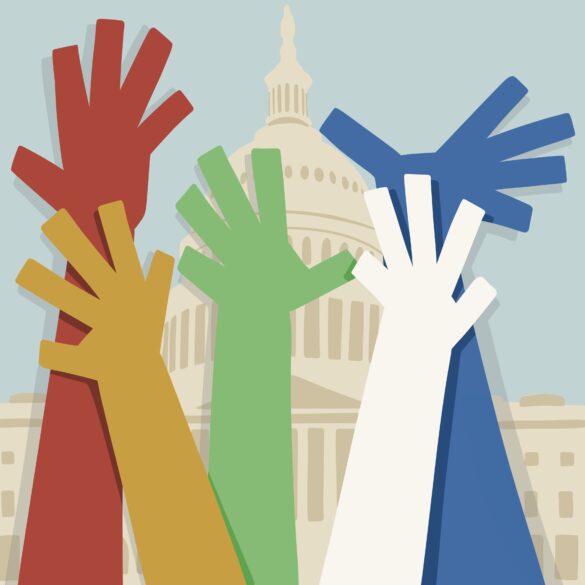In 1796, George Washington stepped down after serving two terms as the first president of the United States. With this decision, he left three main pieces of advice — remain neutral in foreign conflicts, celebrate American achievements, and a final warning of the dangers of political parties.
Washington felt strongly about the ability of political parties to divide Americans in a way that jeopardized liberty, and issued a warning in his Farewell Address.
“However [political parties] may now and then answer popular ends, they are likely in the course of time and things, to become potent engines, by which cunning, ambitious, and unprincipled men will be enabled to subvert the power of the people and to usurp for themselves the reins of government,” Washington says.
Today, political parties are traditionally seen as the Republican and Democratic parties. However, there are also third-party groups including the Libertarian Party, Green Party, and Constitution Party. These parties often struggle to get large followings because, according to the State Court Report, the process for third parties and independent candidates to appear on a ballot is more complicated than for major party candidates.
Third-party candidates can qualify for future elections by achieving a certain number of votes in the most recent elections, by submitting petitions with a certain number of signatures, or by filling out paperwork to run as a write-in candidate.
Breaking down parties
According to the official Democratic Party website, the party promotes a platform that includes progressive and liberal policies. The highlights for the party often include healthcare reforms, environmental protection, and social justice. The website describes Democrats as a party of inclusion that strives for diversity and moving the country forward.
The Republican Party promotes conservative and right-leaning policies, according to the offical GOP website. The party broadly advocates for traditional values, a low degree of government interference, and large support of the private sector. Their platform has a strong focus on family and individual freedom as well as promoting state and local rights.
Founded in 1971, The Libertarian Party advocates for individual liberty, limited government, and free-market principles. With their slogan, “the party of principle,” Libertarians emphasize personal freedom including civil liberties, minimal state intervention, and reduced government spending. According to the Libertarian official website, the party believes that the government’s only responsibility should be protecting people from force and fraud.
The Constitution Party was founded on three pillars — integrity, liberty, and prosperity. With a focus on family, the constitution, life, and state rights. The Constitution Party’s goal, according to their official website, is to limit the federal government to its delegated, enumerated, and constitutional functions. Key issues for the party include gun rights, foreign policy, and immigration.
Lastly, The Green Party advocates for environmental sustainability, social justice, and grassroots democracy. The party got its start in 1972 and focuses on issues such as combating climate change, economic equality, healthcare for all, and reforming the political system to enhance transparency and accountability.
Up and down the aisles
Sean Hildebrand, a professor of political science at Ball State, shared that the first political parties in the U.S. were the Federalists and Anti-Federalists. According to the Library of Congress, Federalist and Anti-Federalist parties began after the founding fathers started to question how powerful the federal government would be.
“The Federalists were for a stronger central government, while the Anti-Federalists feared that would lead to another monarchy-like rule,” Hildebrand says.
According to Norwich University, these factions evolved into broader political parties, such as the Democratic-Republican Party, which eventually became today’s Democratic Party. The Federalist Party dissolved into the Whig Party and later transformed into the Republican Party by the 1850s.
Hildebrand stated that while political parties are accepting of anyone who’d like to support them, there are pros and cons. He believes that each party is accepting and aims to collect as many votes as possible. Regardless of this, the tradition of two parties has led to the idea of “big tents.”
He describes the benefit of these “big tents” as anyone can participate, but the downside is that registering as an affiliation helps parties “figure out how to target” voters.
“There’s nothing that says we can only have two parties, it’s just that we’ve had 160-170 years of tradition with these two, and they’ve made the rules,” Hildebrand says.
Associate Professor of Political Science Chad Kinsella highlighted the Green Party and the Libertarian Party as the most notable outside of the two major parties. Kinsella added that while the Libertarian Party has gained traction in Indiana, other smaller parties like the Socialist Party and Family Party often find support in urban areas.
“In places like Minneapolis, you’ll see these parties doing well,” he explained, referencing a local election where a seat was won by a candidate from a smaller party.
Kinsella also reflected on the historical context of political parties in the U.S., noting that not only did George Washington warn against their formation, but the current electoral system tends to favor a two-party structure.
“There’s no incentive for the major parties to change the rules that benefit them,” Kinsella says.
As political identity becomes more intertwined with personal beliefs, Kinsella expressed concern over polarization and the defining ideologies of parties becoming “a little fuzzy.”
Although Washington’s warning about political parties was over two centuries ago, parties continue to transform and impact the lives of Americans daily.
Contact Cristal Mariano via email at cmarianovargas@bsu.edu.
Sources: Mount Vernon, State Court Report, Democratic Party, Republican Party, Libertarian Party, Constitution Party, Green Party, Library of Congress, Norwich University




